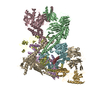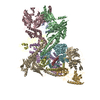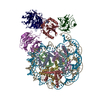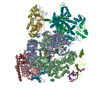+ データを開く
データを開く
- 基本情報
基本情報
| 登録情報 | データベース: PDB / ID: 6vnw | ||||||
|---|---|---|---|---|---|---|---|
| タイトル | Cryo-EM structure of apo-BBSome | ||||||
 要素 要素 |
| ||||||
 キーワード キーワード | PROTEIN TRANSPORT | ||||||
| 機能・相同性 |  機能・相同性情報 機能・相同性情報establishment of anatomical structure orientation / BBSome-mediated cargo-targeting to cilium / receptor localization to non-motile cilium / multi-ciliated epithelial cell differentiation / BBSome / renal tubule development / camera-type eye photoreceptor cell differentiation / smoothened binding / establishment of planar polarity / photoreceptor connecting cilium ...establishment of anatomical structure orientation / BBSome-mediated cargo-targeting to cilium / receptor localization to non-motile cilium / multi-ciliated epithelial cell differentiation / BBSome / renal tubule development / camera-type eye photoreceptor cell differentiation / smoothened binding / establishment of planar polarity / photoreceptor connecting cilium / inner ear receptor cell stereocilium organization / patched binding / olfactory bulb development / establishment of epithelial cell apical/basal polarity / protein localization to cilium / phosphatidylinositol-3-phosphate binding / regulation of stress fiber assembly / non-motile cilium assembly / non-motile cilium / centrosome cycle / eating behavior / motile cilium / erythrocyte homeostasis / ciliary membrane / fat cell differentiation / pericentriolar material / B cell homeostasis / axoneme / cilium assembly / axon guidance / protein localization to plasma membrane / centriolar satellite / multicellular organism growth / Wnt signaling pathway / fibrillar center / sensory perception of smell / intracellular protein localization / protein transport / regulation of protein localization / protein-macromolecule adaptor activity / gene expression / RNA polymerase II-specific DNA-binding transcription factor binding / neuron projection / cilium / ciliary basal body / centrosome / membrane / cytoplasm 類似検索 - 分子機能 | ||||||
| 生物種 |  | ||||||
| 手法 | 電子顕微鏡法 / 単粒子再構成法 / クライオ電子顕微鏡法 / 解像度: 3.44 Å | ||||||
 データ登録者 データ登録者 | Yang, S. / Walz, T. / Nachury, M. / Chou, H. | ||||||
| 資金援助 |  米国, 1件 米国, 1件
| ||||||
 引用 引用 |  ジャーナル: Elife / 年: 2020 ジャーナル: Elife / 年: 2020タイトル: Near-atomic structures of the BBSome reveal the basis for BBSome activation and binding to GPCR cargoes. 著者: Shuang Yang / Kriti Bahl / Hui-Ting Chou / Jonathan Woodsmith / Ulrich Stelzl / Thomas Walz / Maxence V Nachury /   要旨: Dynamic trafficking of G protein-coupled receptors (GPCRs) out of cilia is mediated by the BBSome. In concert with its membrane recruitment factor, the small GTPase ARL6/BBS3, the BBSome ferries ...Dynamic trafficking of G protein-coupled receptors (GPCRs) out of cilia is mediated by the BBSome. In concert with its membrane recruitment factor, the small GTPase ARL6/BBS3, the BBSome ferries GPCRs across the transition zone, a diffusion barrier at the base of cilia. Here, we present the near-atomic structures of the BBSome by itself and in complex with ARL6, and we describe the changes in BBSome conformation induced by ARL6 binding. Modeling the interactions of the BBSome with membranes and the GPCR Smoothened (SMO) reveals that SMO, and likely also other GPCR cargoes, must release their amphipathic helix 8 from the membrane to be recognized by the BBSome. | ||||||
| 履歴 |
|
- 構造の表示
構造の表示
| ムービー |
 ムービービューア ムービービューア |
|---|---|
| 構造ビューア | 分子:  Molmil Molmil Jmol/JSmol Jmol/JSmol |
- ダウンロードとリンク
ダウンロードとリンク
- ダウンロード
ダウンロード
| PDBx/mmCIF形式 |  6vnw.cif.gz 6vnw.cif.gz | 643.6 KB | 表示 |  PDBx/mmCIF形式 PDBx/mmCIF形式 |
|---|---|---|---|---|
| PDB形式 |  pdb6vnw.ent.gz pdb6vnw.ent.gz | 502.5 KB | 表示 |  PDB形式 PDB形式 |
| PDBx/mmJSON形式 |  6vnw.json.gz 6vnw.json.gz | ツリー表示 |  PDBx/mmJSON形式 PDBx/mmJSON形式 | |
| その他 |  その他のダウンロード その他のダウンロード |
-検証レポート
| 文書・要旨 |  6vnw_validation.pdf.gz 6vnw_validation.pdf.gz | 762.7 KB | 表示 |  wwPDB検証レポート wwPDB検証レポート |
|---|---|---|---|---|
| 文書・詳細版 |  6vnw_full_validation.pdf.gz 6vnw_full_validation.pdf.gz | 822.8 KB | 表示 | |
| XML形式データ |  6vnw_validation.xml.gz 6vnw_validation.xml.gz | 97.6 KB | 表示 | |
| CIF形式データ |  6vnw_validation.cif.gz 6vnw_validation.cif.gz | 151.9 KB | 表示 | |
| アーカイブディレクトリ |  https://data.pdbj.org/pub/pdb/validation_reports/vn/6vnw https://data.pdbj.org/pub/pdb/validation_reports/vn/6vnw ftp://data.pdbj.org/pub/pdb/validation_reports/vn/6vnw ftp://data.pdbj.org/pub/pdb/validation_reports/vn/6vnw | HTTPS FTP |
-関連構造データ
- リンク
リンク
- 集合体
集合体
| 登録構造単位 | 
|
|---|---|
| 1 |
|
- 要素
要素
-Bardet-Biedl syndrome ... , 6種, 6分子 HBEGCI
| #1: タンパク質 | 分子量: 8070.502 Da / 分子数: 1 / 由来タイプ: 天然 / 由来: (天然)  |
|---|---|
| #2: タンパク質 | 分子量: 79911.484 Da / 分子数: 1 / 由来タイプ: 天然 / 由来: (天然)  |
| #3: タンパク質 | 分子量: 58289.133 Da / 分子数: 1 / 由来タイプ: 天然 / 由来: (天然)  |
| #4: タンパク質 | 分子量: 38880.984 Da / 分子数: 1 / 由来タイプ: 天然 / 由来: (天然)  |
| #5: タンパク質 | 分子量: 80471.375 Da / 分子数: 1 / 由来タイプ: 天然 / 由来: (天然)  |
| #7: タンパク質 | 分子量: 99230.914 Da / 分子数: 1 / 由来タイプ: 天然 / 由来: (天然)  |
-タンパク質 , 2種, 2分子 FD
| #6: タンパク質 | 分子量: 56686.406 Da / 分子数: 1 / 由来タイプ: 天然 / 由来: (天然)  |
|---|---|
| #8: タンパク質 | 分子量: 64939.141 Da / 分子数: 1 / 由来タイプ: 天然 / 由来: (天然)  |
-実験情報
-実験
| 実験 | 手法: 電子顕微鏡法 |
|---|---|
| EM実験 | 試料の集合状態: PARTICLE / 3次元再構成法: 単粒子再構成法 |
- 試料調製
試料調製
| 構成要素 | 名称: BBSome complex / タイプ: COMPLEX / Entity ID: all / 由来: NATURAL | |||||||||||||||||||||||||
|---|---|---|---|---|---|---|---|---|---|---|---|---|---|---|---|---|---|---|---|---|---|---|---|---|---|---|
| 分子量 | 値: 0.5 MDa / 実験値: NO | |||||||||||||||||||||||||
| 由来(天然) | 生物種:  | |||||||||||||||||||||||||
| 緩衝液 | pH: 7.5 | |||||||||||||||||||||||||
| 緩衝液成分 |
| |||||||||||||||||||||||||
| 試料 | 濃度: 0.4 mg/ml / 包埋: NO / シャドウイング: NO / 染色: NO / 凍結: YES | |||||||||||||||||||||||||
| 試料支持 | グリッドの材料: COPPER / グリッドのサイズ: 400 divisions/in. / グリッドのタイプ: Quantifoil R1.2/1.3 | |||||||||||||||||||||||||
| 急速凍結 | 装置: FEI VITROBOT MARK IV / 凍結剤: ETHANE / 湿度: 100 % / 凍結前の試料温度: 277 K / 詳細: Wait time 20s, blot force -2, blot time 3.5s |
- 電子顕微鏡撮影
電子顕微鏡撮影
| 実験機器 |  モデル: Titan Krios / 画像提供: FEI Company |
|---|---|
| 顕微鏡 | モデル: FEI TITAN KRIOS |
| 電子銃 | 電子線源:  FIELD EMISSION GUN / 加速電圧: 300 kV / 照射モード: FLOOD BEAM FIELD EMISSION GUN / 加速電圧: 300 kV / 照射モード: FLOOD BEAM |
| 電子レンズ | モード: BRIGHT FIELD |
| 撮影 | 電子線照射量: 80 e/Å2 / 検出モード: SUPER-RESOLUTION フィルム・検出器のモデル: GATAN K2 SUMMIT (4k x 4k) |
- 解析
解析
| EMソフトウェア |
| ||||||||||||
|---|---|---|---|---|---|---|---|---|---|---|---|---|---|
| CTF補正 | タイプ: PHASE FLIPPING AND AMPLITUDE CORRECTION | ||||||||||||
| 対称性 | 点対称性: C1 (非対称) | ||||||||||||
| 3次元再構成 | 解像度: 3.44 Å / 解像度の算出法: FSC 0.143 CUT-OFF / 粒子像の数: 560777 / 対称性のタイプ: POINT |
 ムービー
ムービー コントローラー
コントローラー













 PDBj
PDBj


